External wall insulation delivers powerful benefits that’ll transform your home’s performance and value. You’ll see up to 45% reduction in energy bills, enhanced year-round comfort, and protection against weather damage. It’ll boost your property’s market value by 5-15% while reducing your carbon footprint and maintenance costs. With government grants up to £9,000 available for Scottish residents, this proven solution offers both immediate and long-term returns. Discover how this investment can revolutionize your home’s efficiency.
Key Takeaways
- External wall insulation saves £225-£375 annually on energy bills and increases property value by up to 15%.
- Scottish residents can access up to £9,000 in government grants to offset installation costs.
- The insulation maintains consistent indoor temperatures year-round while preventing condensation and mold growth.
- It protects structural walls from weather damage, reducing maintenance costs and extending building lifespan.
- External wall insulation significantly reduces carbon emissions and supports the UK’s environmental goals.
Significant Energy Bill Savings
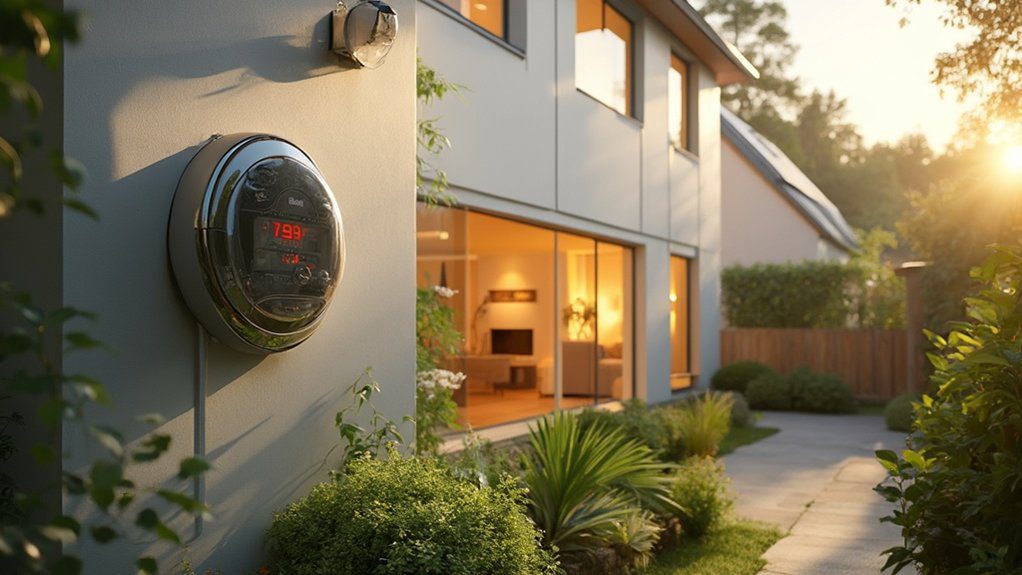
Efficiency drives substantial cost reduction when external wall insulation is properly installed.
You’ll notice immediate improvements in your home’s energy efficiency as the insulation creates a protective barrier that prevents heat from escaping during winter and keeps your home cooler in summer.
Your investment in external wall insulation typically pays for itself within 5-7 years through reduced energy bills.
You can expect to save between £225-£375 annually on heating costs for a typical semi-detached house.
This cost reduction becomes even more significant as energy prices continue to rise.
Enhanced Indoor Comfort All Year Round
Once installed, external wall insulation transforms your home’s internal environment by maintaining consistent temperatures throughout the year.
You’ll notice how your living spaces remain cooler during summer months and warmer in winter, creating ideal indoor temperature conditions for your family.
The insulation acts as a protective barrier, preventing heat from escaping during cold periods and blocking excess heat from entering during warmer seasons.
This balanced seasonal comfort means you won’t experience those frustrating cold spots or overheated rooms that are common in poorly insulated homes.
The stabilized environment also reduces condensation and dampness, which helps prevent mold growth and creates healthier living conditions.
Your home becomes a more comfortable space where you can relax without constantly adjusting your heating or cooling systems.
Boost Your Property’s Market Value
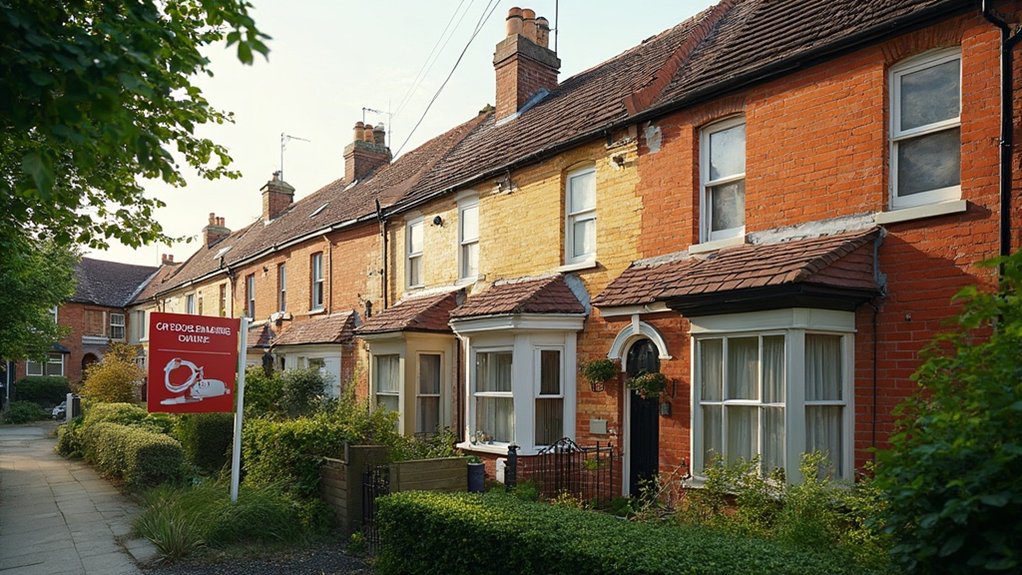
Beyond the comfort benefits, installing external wall insulation can greatly increase your property’s market appeal and financial worth.
Recent market trends show that energy-efficient homes command premium prices, with well-insulated properties typically selling for 5-15% more than their non-insulated counterparts.
When you invest in external wall insulation, you’re not just improving your home’s thermal performance – you’re adding a valuable asset that property appraisal experts consistently recognize.
Your home’s enhanced EPC rating will attract environmentally conscious buyers who prioritize sustainable living and lower energy costs.
As the UK housing market continues to favor energy-efficient properties, your insulated home will stand out among comparable properties in your area, potentially reducing time-to-sale and strengthening your negotiating position.
Protection Against Weather Damage
While traditional exterior walls remain exposed to harsh elements, external wall insulation provides a robust defensive barrier against weather-related deterioration.
You’ll notice enhanced weather resistance as the insulation system shields your home’s structural walls from rain, snow, and temperature fluctuations that typically cause cracks and erosion.
The moisture protection capabilities of external wall insulation prevent dampness from seeping into your home’s fabric.
You’re safeguarding your property against common issues like penetrating damp, frost damage, and salt crystallization that often plague UK homes.
The system’s protective layers work together to redirect water away from your walls, while still allowing them to breathe naturally.
Reduced Carbon Footprint
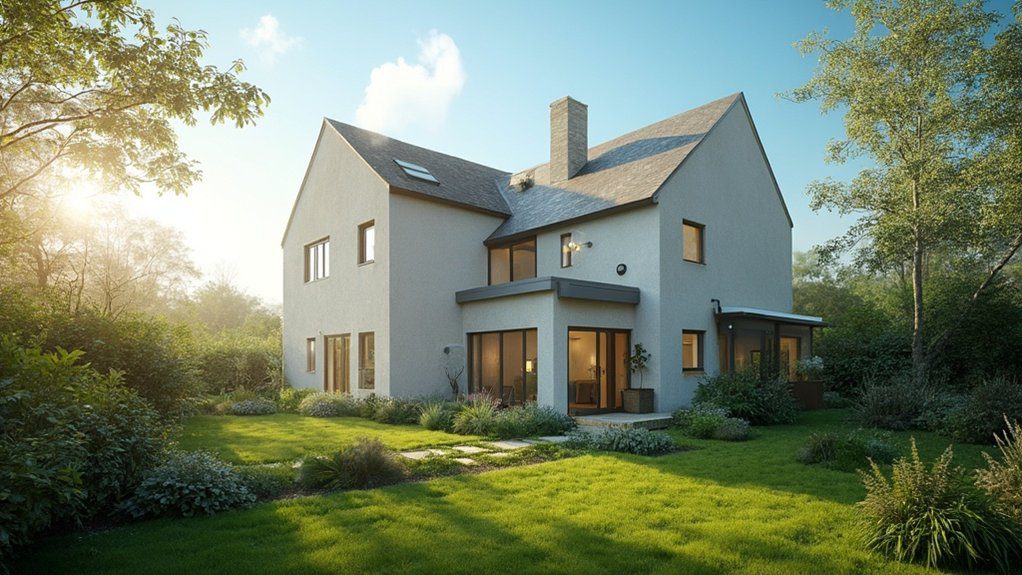
Installing external wall insulation greatly reduces your home’s carbon emissions by minimizing heat loss and energy waste. By implementing this proven carbon reduction strategy, you’ll join thousands of environmentally conscious UK homeowners who’ve decreased their heating requirements by up to 45%.
The eco-friendly materials used in modern external wall insulation systems contribute to sustainability throughout their lifecycle.
You’ll find that mineral wool, expanded polystyrene, and other insulation options are manufactured using processes that minimize environmental impact.
When combined with proper installation, these materials create an effective thermal barrier that lasts decades, reducing your long-term carbon footprint.
You’re not just improving your home’s efficiency; you’re participating in the nationwide effort to meet the UK’s carbon reduction targets and combat climate change through smarter housing solutions.
Eliminate Cold Spots and Damp Issues
External wall insulation directly addresses one of the most common household problems in the UK – persistent cold spots and dampness. You’ll notice a significant improvement in moisture control once you’ve installed this solution, as it prevents thermal bridging where cold exterior surfaces meet interior walls.
| Problem | Cause | Solution |
|---|---|---|
| Cold Spots | Thermal Bridging | Continuous Insulation Layer |
| Condensation | Temperature Differences | Regulated Surface Temperature |
| Rising Damp | Poor Wall Protection | Weatherproof Barrier |
You’re not just fixing surface issues – you’re creating a complete thermal envelope that regulates your home’s temperature and humidity levels. The insulation system prevents warm, moist indoor air from meeting cold surfaces, eliminating conditions that lead to mold growth and persistent dampness. This all-encompassing solution guarantees your home stays comfortable and dry throughout the year.
Modern Aesthetic Appeal and Kerb Appeal
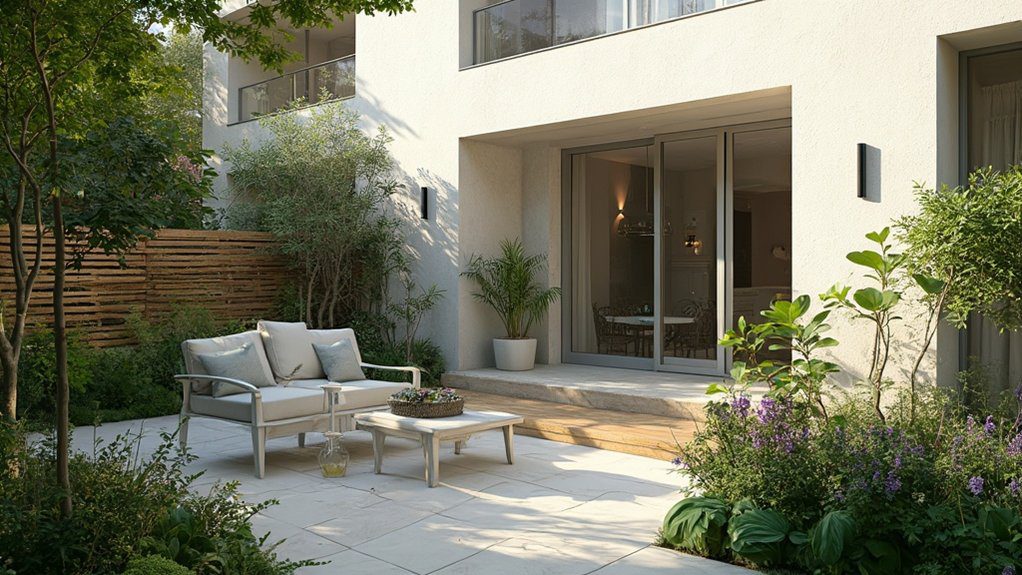
Beyond its practical benefits, modern external wall insulation transforms your home’s appearance with a range of contemporary finish options.
You’ll have access to diverse exterior color options that align with current modern design trends, from sleek render finishes to textured surfaces that mimic traditional materials.
Your property can stand out with sophisticated architectural details, clean lines, and seamless surfaces that instantly modernize its façade.
The system allows you to incorporate decorative beading, quoins, and banding that enhance visual interest while maintaining a cohesive look.
You’ll join other forward-thinking homeowners who’ve increased their property’s kerb appeal through this upgrade.
Whether you choose a minimalist white finish or a bold contemporary shade, external wall insulation helps your home make a striking first impression in your neighborhood.
Superior Sound Insulation Benefits
While modern aesthetics enhance your home’s visual appeal, the acoustic advantages of external wall insulation offer a notable upgrade to your living environment.
The additional layers of insulation material considerably improve your home’s acoustic performance, creating a more peaceful indoor atmosphere. You’ll notice a marked reduction in external noise from traffic, neighbours, and urban activity.
The insulation system acts as an effective sound barrier, reducing noise transmission through your walls by up to 50%.
Whether you’re living near a busy road or in a densely populated area, you’ll experience superior noise reduction that transforms your living space into a tranquil sanctuary.
For UK homeowners dealing with noise pollution, external wall insulation provides a practical solution that enhances both thermal efficiency and acoustic comfort.
Government Grants and Incentives Available
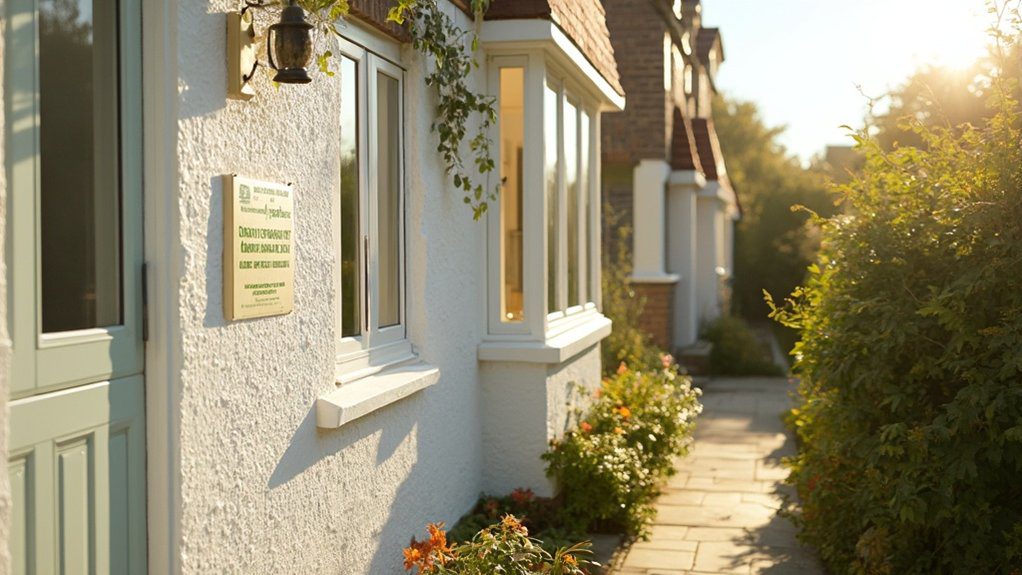
Looking to make your home more energy-efficient without breaking the bank? You’ll be pleased to know there are several government funding schemes and financial incentives available for external wall insulation in the UK.
| Scheme Name | Coverage | Eligibility |
|---|---|---|
| ECO4 | Up to £10,000 | Low-income households |
| Green Homes Grant | 2/3 of costs | All homeowners |
| Home Upgrade Grant | Up to £25,000 | EPC rating D or lower |
| Local Authority Grants | Varies by region | Area-specific criteria |
| Home Energy Scotland | Up to £9,000 | Scottish residents |
These programs can greatly reduce your installation costs, making external wall insulation more accessible. You’ll need to check your eligibility through official channels and work with approved installers to access these benefits. Don’t miss out on these opportunities to upgrade your home while saving money through government support.
Extended Lifespan of Your Building’s Structure
The investment in external wall insulation delivers value far beyond energy savings and government incentives.
By protecting your home’s exterior walls from weather damage, you’ll greatly enhance its structural integrity and reduce the need for frequent building maintenance.
Your property’s walls will face less stress from freeze-thaw cycles that typically cause cracks and deterioration.
The insulation layer acts as a protective shield, preventing rainwater penetration and reducing the risk of damp-related issues that can compromise your building’s foundation.
You’re effectively adding a defensive barrier that guards against thermal movement, which can lead to structural problems over time.
This protection means you’ll spend less on repairs while extending your property’s lifespan by decades, making it a smart investment in your home’s long-term future.
Frequently Asked Questions
How Long Does External Wall Insulation Installation Typically Take to Complete?
You’ll find the installation duration of external wall insulation typically takes 2-3 weeks for an average home. Your project timeline can vary based on weather conditions, property size, and preparation requirements.
Can External Wall Insulation Be Installed on Any Type of Property?
While 85% of UK homes can benefit from EWI, you’ll find that installation methods vary by property types. Your solid wall, cavity wall, or timber-framed home can typically receive EWI, though each requires specific application techniques.
Do I Need Planning Permission to Install External Wall Insulation?
You’ll typically need planning permission for external wall insulation if you’re in a conservation area or listed building. For standard properties, you’re often exempt, but check local planning regulations before starting your project.
What Maintenance Is Required for External Wall Insulation?
You’d think external wall insulation needs constant attention, but it doesn’t. You’ll just need annual visual inspections, occasional cleaning, and prompt repairs of any cracks or damage using manufacturer-approved repair techniques.
Will External Wall Insulation Affect My Home’s Original Architectural Features?
You can maintain architectural harmony by choosing insulation aesthetics that complement your home’s features. Modern systems offer various finishes and textures that’ll preserve your property’s character while improving its thermal performance.
Conclusion
External wall insulation represents a significant investment in your property’s future performance and value. You’ll see tangible benefits like the 45% average reduction in heating costs reported by the Building Research Establishment. For a typical three-bedroom semi-detached house, installation costs of £8,000-£12,000 can be offset through energy savings within 8-10 years while simultaneously upgrading your home’s thermal efficiency, weather resistance, and market appeal.

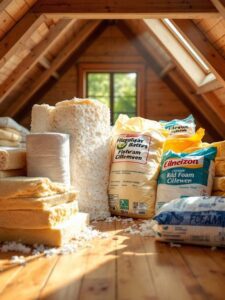
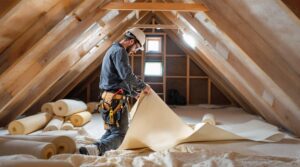

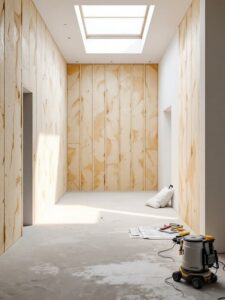



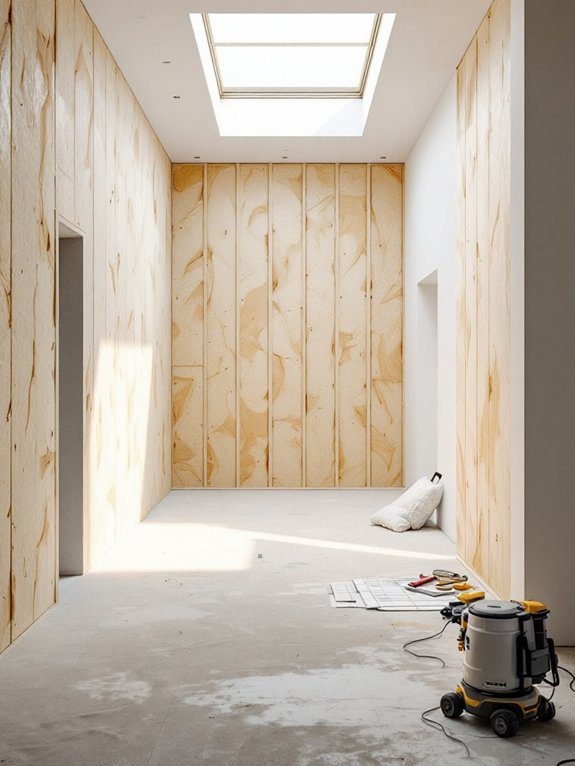
17 Responses
whoah this blog is great i love reading your posts. Keep up the good work! You know, lots of people are looking around for this info, you can help them greatly.
With everything which appears to be developing throughout this area, your opinions tend to be somewhat refreshing. Having said that, I appologize, but I do not subscribe to your whole theory, all be it exciting none the less. It would seem to everyone that your comments are not entirely validated and in simple fact you are your self not even fully certain of your argument. In any event I did take pleasure in reading it.
You are a very clever person!
Great goods from you, man. I have understand your stuff previous to and you’re just too magnificent. I really like what you’ve acquired here, certainly like what you are saying and the way in which you say it. You make it enjoyable and you still take care of to keep it smart. I can’t wait to read far more from you. This is really a great site.
I like the valuable info you provide in your articles. I will bookmark your weblog and check again here frequently. I am quite certain I will learn plenty of new stuff right here! Best of luck for the next!
You should take part in a contest for one of the best blogs on the web. I will recommend this site!
Valuable information. Lucky me I found your website by accident, and I’m shocked why this accident did not happened earlier! I bookmarked it.
I am often to blogging and i really appreciate your content. The article has really peaks my interest. I am going to bookmark your site and keep checking for new information.
Someone essentially help to make seriously articles I’d state. This is the first time I frequented your web page and to this point? I amazed with the analysis you made to create this particular submit amazing. Fantastic process!
Your point of view caught my eye and was very interesting. Thanks. I have a question for you. https://accounts.binance.info/vi/register-person?ref=MFN0EVO1
Your point of view caught my eye and was very interesting. Thanks. I have a question for you.
F*ckin¦ amazing issues here. I¦m very satisfied to see your post. Thanks so much and i’m looking ahead to touch you. Will you please drop me a e-mail?
I am often to blogging and i really appreciate your content. The article has really peaks my interest. I am going to bookmark your site and keep checking for new information.
Keep working ,impressive job!
Hi, Neat post. There’s an issue together with your site in internet explorer, might check this… IE nonetheless is the market chief and a big portion of other people will miss your excellent writing due to this problem.
An interesting discussion is worth comment. I think that you should write more on this topic, it might not be a taboo subject but generally people are not enough to speak on such topics. To the next. Cheers
I genuinely enjoy looking through on this web site, it has wonderful posts.